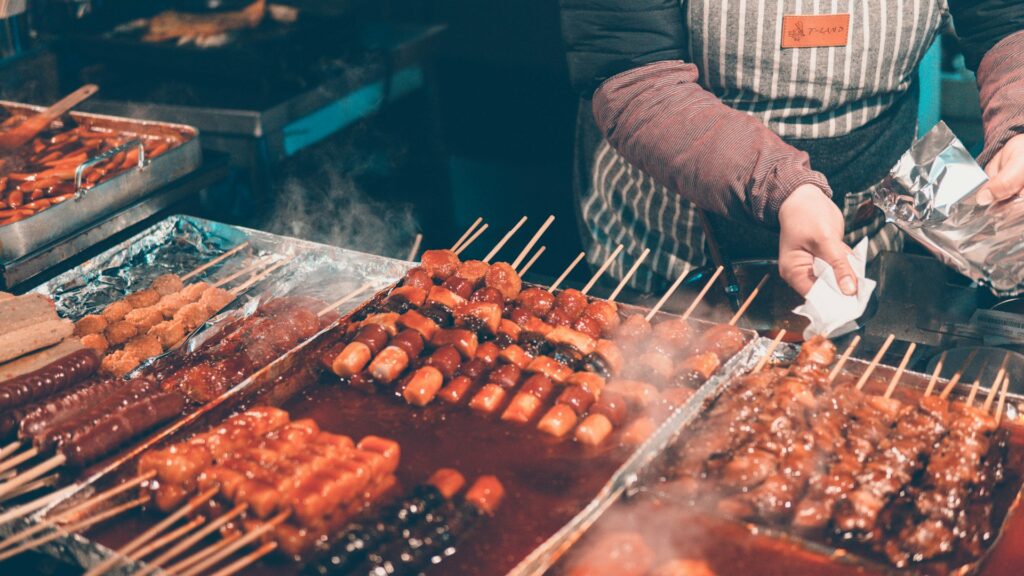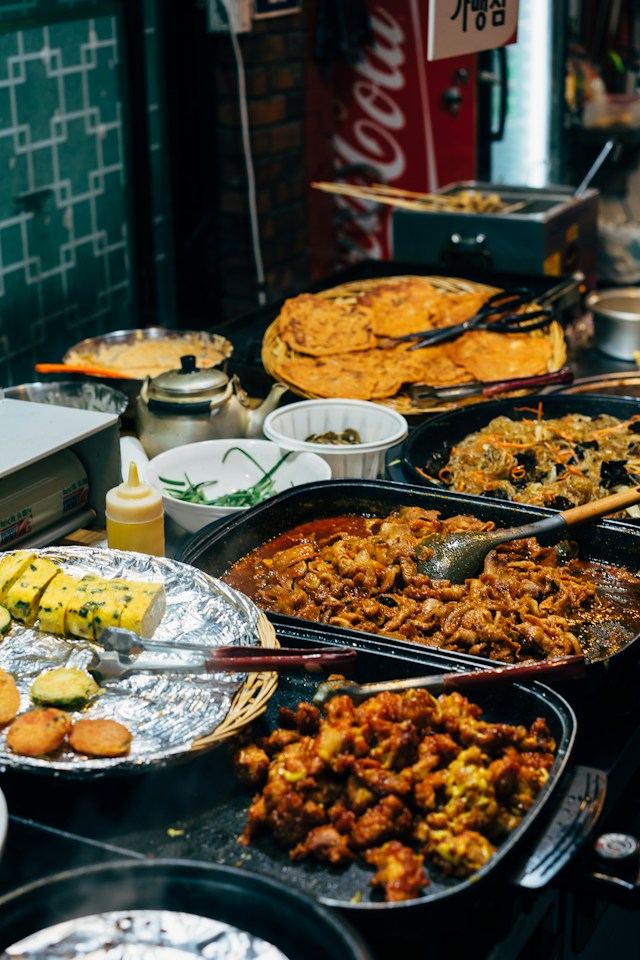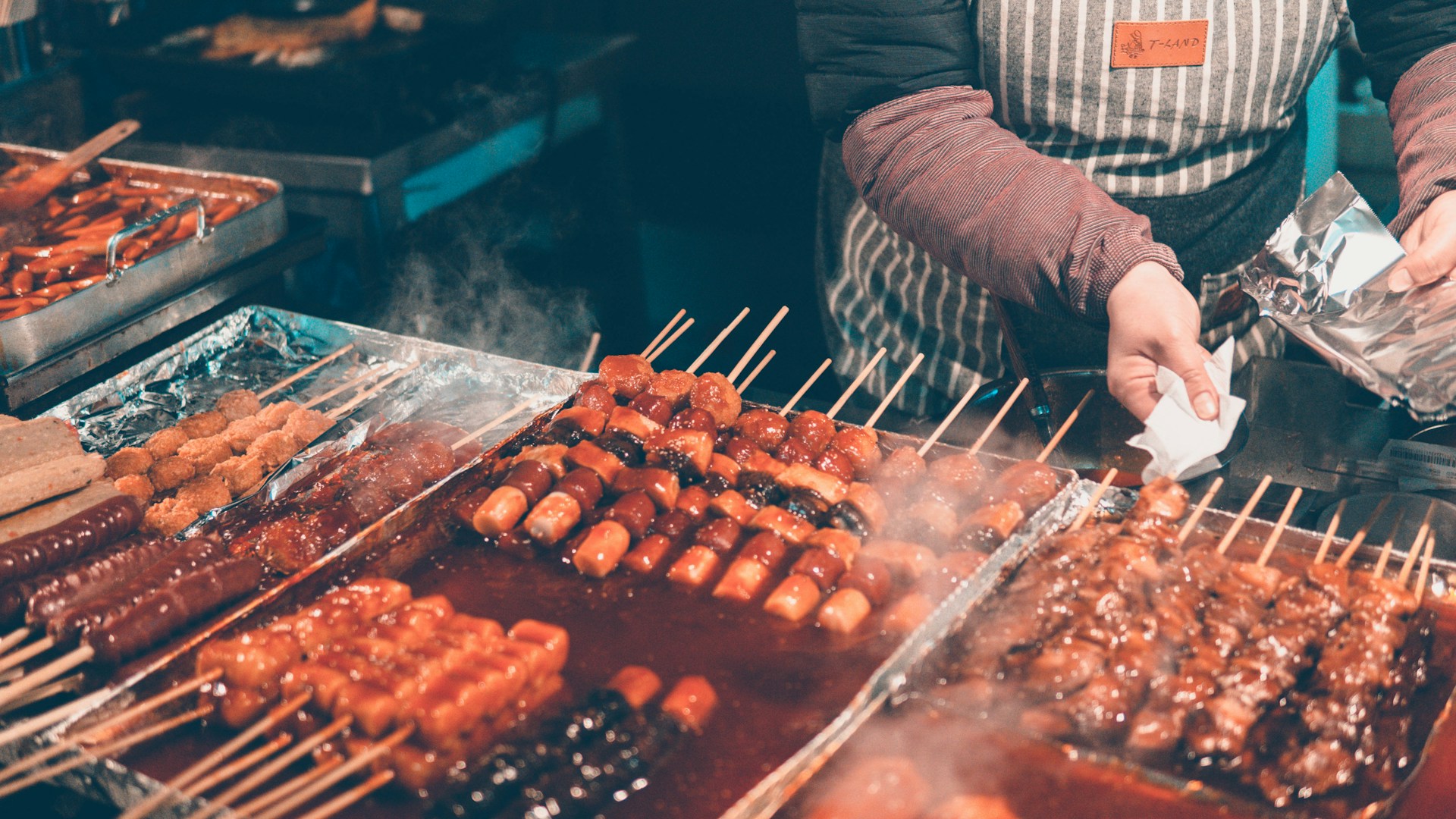Myeongdong’s street food scene is a dynamic showcase of Korea’s rich and diverse food culture. Here, traditional flavors meet modern innovation, creating an ever-evolving tapestry of tastes and experiences.
In Korean cuisine, the use of seasonal ingredients is not just a practice but a philosophy deeply rooted in history and culture. This emphasis on seasonality is driven by the belief that food should be consumed at its freshest, most flavorful state. Seasonal eating is not only about enjoying the best of what nature offers at a particular time of the year but also about harmonizing with the natural cycle and rhythm of the environment.
In Myeongdong, this philosophy comes to life in the most delightful way. Each season brings its own unique offerings to the street food stalls, reflecting the changing landscapes and the seasonal produce available. From the fresh, vibrant flavors of spring to the hearty, warming dishes of winter, Myeongdong’s street food scene offers a true feast for the senses.
Join us as we embark on a delicious journey through the seasons, exploring the must-try street foods that make Myeongdong a culinary destination like no other. Whether you’re a seasoned foodie or a curious traveler, there’s something in these streets for everyone to savor and enjoy.
Why Seasonal Street Food?
When it comes to enjoying street food in Myeongdong, timing is everything. The changing seasons not only bring a shift in weather but also a delightful transformation in the food offerings that line these bustling streets. Let’s delve into why indulging in seasonal street food is a journey worth taking.
1. Freshness and Flavor
The Heart of Seasonal Eating
The most compelling reason to eat seasonally is the unmatched freshness and flavor it brings. Seasonal produce is harvested at the peak of its growth, ensuring that the ingredients are naturally ripe, bursting with nutrients, and rich in taste. This is particularly evident in Myeongdong’s street food, where the seasonal ingredients shine as the stars of each dish.
In spring, vendors showcase dishes with tender greens and fresh seafood, while summer brings an abundance of fruits and light, refreshing fare. Autumn’s harvest offers a bounty of root vegetables and grains, leading into winter, where hearty, warming foods take center stage. Each season’s distinct flavors are celebrated, offering a sensory experience that is deeply connected to the time of year.
2. Sustainability
Supporting Local and Reducing Environmental Impact
Seasonal eating also aligns with sustainable practices. By consuming foods that are in season locally, we support local farmers and reduce the environmental impact associated with long-distance transportation of out-of-season produce. In Myeongdong, many street food vendors source their ingredients from nearby regions, ensuring that what you’re eating not only tastes better but also contributes to a smaller carbon footprint.
3. Seasonal Changes
A Kaleidoscope of Culinary Delights
As the seasons change in Seoul, so does the landscape of Myeongdong’s street food scene. Each season ushers in new flavors and dishes, making each visit a unique culinary adventure. In the spring, the streets are adorned with cherry blossoms, and the food reflects this with light and fresh ingredients. Summer sees a surge in cold, refreshing treats to beat the heat. Come autumn, the food becomes richer and more comforting, with an array of stews and roasted snacks. Winter welcomes warming dishes that provide solace in the chilly weather.
This ever-changing menu not only keeps the street food scene exciting and diverse but also offers an authentic taste of Korean culinary traditions. Seasonal street food in Myeongdong is a reflection of the country’s deep respect for nature and its cycles, a tradition that is both delicious and meaningful.
Spring Delights in Myeongdong
As the chill of winter fades and gives way to the blooming beauty of spring, Myeongdong undergoes a magical transformation. The arrival of spring breathes new life into the street food scene, introducing an array of dishes that celebrate the freshness and vibrancy of the season.

Common Spring Ingredients in Korean Street Food
Spring in Korea is a time of renewal and rejuvenation, and this is beautifully reflected in the ingredients that dominate the street food during this season. Key ingredients include:
- Young Greens and Wild Vegetables (Namul): Spring is the season for fresh, tender greens. You’ll find a variety of wild vegetables and herbs being incorporated into dishes, adding a burst of freshness and a subtle earthy flavor.
- Spring Onions (Pa): These add a crisp, mildly spicy note to many dishes and are essential in Korean cooking during spring.
- Seafood: With the waters around Korea teeming with life, spring sees an abundance of fresh seafood in Myeongdong’s street food stalls.
Top Picks for Spring Street Food in Myeongdong
1. Cherry Blossom Cakes (Beotkkot Baengseon)
These delightful cakes are a tribute to the beautiful cherry blossoms that adorn the streets of Seoul in spring. Light and airy, they are often filled with sweet red bean paste, making them a perfect, picturesque treat.
2. Spring Onion Pancakes (Pa Jeon)
A classic Korean dish, these savory pancakes are loaded with fresh spring onions. Crispy on the outside and soft on the inside, Pa Jeon is a must-try, especially when enjoyed with a light dipping sauce.
3. Grilled Fish (Gui)
Spring is a great time for seafood, and grilled fish becomes a popular item in Myeongdong. Look for stalls grilling mackerel or other seasonal fish, served hot and fresh with a variety of side dishes.
4. Strawberry Mochi (Ddalgi Chapssal Tteok)
Spring is strawberry season in Korea, and these sweet, juicy fruits are celebrated in the form of strawberry mochi. These chewy rice cakes filled with fresh strawberries and sweet red bean paste are not only delicious but also visually appealing.
5. Noodle Dishes (Kalguksu or Janchi Guksu)
With the warmer weather, lighter meals like noodle dishes become popular. Handmade, knife-cut noodles (Kalguksu) or banquet noodles (Janchi Guksu) in a clear, savory broth are both comforting and refreshing.
Spring in Myeongdong is a celebration of freshness, with each dish offering a taste of the season’s bounty. As you explore the streets, let the fresh flavors of spring guide your culinary journey, and revel in the joy of seasonal eating.
Summer Sizzlers in Myeongdong
As summer arrives in Seoul, Myeongdong’s street food scene adapts to the warmer temperatures with an array of dishes that are both refreshing and invigorating. Summer in Korea is characterized by hot and humid weather, and the street food during this season is designed not just to satisfy hunger but also to provide relief from the heat.
Summer Ingredients and Their Significance in Korean Culture
Summer in Korea brings with it a variety of fresh and cooling ingredients, each holding a special place in the country’s culinary traditions:
- Fruits: Watermelon, melon, and peaches are summer staples. These fruits are not only enjoyed on their own but also incorporated into various street food items for their cooling effects.
- Cold Noodles: Ingredients like buckwheat and sweet potato starch are used to make cold noodles, a popular summer dish believed to help beat the heat.
- Mountain Vegetables: Gathered from the mountains, these vegetables are a testament to Korea’s deep connection with nature and are often used in refreshing summer salads.
Must-Try Summer Street Foods in Myeongdong
1. Cold Noodles (Naengmyeon)
A classic summer dish, these cold, chewy noodles are served in a tangy iced broth, often with slices of cucumber, pear, and a boiled egg. The dish is known for its refreshing and revitalizing properties.
2. Bingsu
This popular shaved ice dessert is a summer favorite. Topped with sweet red beans, fruit, and condensed milk, it’s the perfect treat to cool down on a hot summer day.
3. Fruit Skewers
Fresh fruit skewers, often featuring watermelon, pineapple, and melon, are a healthy and refreshing snack. They’re sometimes coated in a light candy glaze, adding a delightful sweetness.
4. Korean Fried Chicken
While available year-round, Korean fried chicken, especially when paired with ice-cold beer (known as “chimaek”), becomes a popular choice for summer evenings in Myeongdong.
5. Corn on the Cob (Oksusu)
Grilled or steamed, sweet Korean corn is a simple yet satisfying summer snack, often seasoned with butter and salt.
Summer in Myeongdong offers a delightful culinary escape from the heat. The season’s street food is not only about tantalizing your taste buds but also about providing comfort and refreshment. Each dish tells a story of Korean culture’s adaptation to the season, making it a unique and memorable part of your Seoul adventure.
Autumn Aromas in Myeongdong
As the leaves begin to turn in Seoul, Myeongdong’s street food scene shifts to embrace the bounty of autumn. This season, known as the harvest time, is celebrated throughout Korea for its rich culinary traditions and the abundance of fresh, flavorful ingredients.
Autumnal Ingredients and Their Role in Harvest Festivals
Autumn in Korea is marked by Chuseok, also known as Korean Thanksgiving, a time when families gather to celebrate the harvest and honor their ancestors. The ingredients that define this season play a significant role in these festivities:
- Root Vegetables: Sweet potatoes, radishes, and taro are harvested in autumn and are staple ingredients in many Korean dishes during this season.
- Grains and Beans: Rice, barley, and soybeans, harvested in the fall, are essential in Korean cuisine and are often used in holiday dishes.
- Nuts and Seeds: Chestnuts, walnuts, and pine nuts are popular in autumn and are used in both sweet and savory dishes.
- Persimmons and Apples: These fruits are in their prime during autumn and are enjoyed both fresh and in various culinary preparations.
Recommended Autumn Street Foods in Myeongdong
1. Roasted Chestnuts (Gunbam)
A classic autumn snack, these chestnuts are roasted right on the streets of Myeongdong, filling the air with their warm, nutty aroma.
2. Sweet Potato Snacks (Goguma Mattang)
Candied sweet potatoes, deep-fried and glazed with a honey or sugar syrup, offer a perfect blend of sweet and savory flavors.
3. Rice Cakes (Songpyeon)
Traditionally made during Chuseok, these half-moon-shaped rice cakes are filled with sweet fillings like sesame seeds or red bean paste and are steamed on a bed of pine needles.
4. Hotteok with Autumn Fruits
A popular Korean street food, these sweet pancakes are filled with brown sugar, nuts, and autumn fruits like apples or persimmons, making them an ideal treat for cooler weather.
5. Fish Cake Soup (Eomuk Guk)
As the weather gets colder, a warm bowl of fish cake soup becomes increasingly popular. It’s both comforting and satisfying, perfect for enjoying on a brisk autumn evening.
Autumn in Myeongdong is a time of heartwarming flavors and comforting aromas. The street foods of this season not only offer a glimpse into Korea’s rich harvest traditions but also provide a cozy culinary experience that complements the cool, crisp air of autumn in Seoul.
Winter Warmers in Myeongdong
The winter season in Myeongdong casts a serene and peaceful atmosphere over the bustling streets, as locals and tourists alike seek comfort in warm and hearty street foods. This time of year, characterized by cold temperatures and sometimes snow, calls for dishes that not only satisfy hunger but also provide warmth and solace.
Winter Ingredients and Their Comforting Qualities
Winter in Korea brings with it a range of ingredients known for their ability to warm the body and spirit:
- Root Vegetables: Vegetables like radishes, sweet potatoes, and carrots, which are stored well into the winter, are commonly used in Korean winter dishes for their earthy flavors and nourishing qualities.
- Red Beans: Known for their warming properties, red beans are a popular ingredient in sweet winter treats.
- Meats and Seafood: Hearty meats and fortifying seafood play a significant role in winter cuisine, offering both warmth and sustenance.
- Kimchi and Fermented Foods: Winter is the time for kimchi and other fermented foods, which are not only warming but also provide essential nutrients.
Winter Street Food Favorites in Myeongdong
1. Hotteok (Sweet Pancakes)
These sweet, syrup-filled pancakes are a winter favorite. The dough is typically filled with a mixture of brown sugar, cinnamon, and nuts, then cooked to a golden brown, offering a warm and comforting treat on a cold day.
2. Fish Cake Soup (Eomuk Guk or Odeng)
This hot and savory soup, with its fish cakes and rich, warming broth, is a staple of winter street food. Often served with a side of radish pickles, it’s the perfect way to warm up.
3. Tteokbokki (Spicy Rice Cakes)
While enjoyed year-round, Tteokbokki becomes especially popular in winter. The combination of chewy rice cakes in a spicy, sweet sauce provides both heat and comfort.
4. Baked Sweet Potatoes (Gun Goguma)
Roasted sweet potatoes are a simple yet satisfying winter snack. Their natural sweetness and warmth make them an ideal choice for a chilly day.
5. Mandu (Korean Dumplings)
These dumplings, filled with meat, vegetables, or tofu, are often enjoyed steamed or fried. They offer a heartwarming and filling option for winter street food.
Winter in Myeongdong is a time to indulge in foods that warm the body and lift the spirits. The street food during this season is all about comfort, with each dish offering a cozy refuge from the cold.
Year-Round Staples in Myeongdong
While Myeongdong’s street food scene is a kaleidoscope of seasonal delights, there are certain dishes that have earned their status as all-time favorites, relished by visitors and locals throughout the year. These staples of Myeongdong’s street food culture offer a taste of Korea’s culinary essence, regardless of the season.
Timeless Classics of Myeongdong’s Streets
These year-round street foods are not only popular for their delicious flavors but also for their ability to represent Korean cuisine’s diversity and history:
1. Tteokbokki (Spicy Rice Cakes)
Perhaps one of the most iconic Korean street foods, Tteokbokki is a beloved snack at any time of the year. It features chewy rice cakes bathed in a sweet and spicy sauce made from gochujang (Korean chili paste). Often accompanied by fish cakes and boiled eggs, Tteokbokki is a quintessential Korean comfort food that perfectly balances spice, sweetness, and savoriness.
2. Korean Fried Chicken (Chikin)
Korean fried chicken has gained international fame for its incredibly crispy exterior and juicy interior. Often flavored with a variety of sauces, from soy garlic to sweet and spicy, it’s a favorite among locals and tourists alike. Enjoyed with a cold beer, this dish transcends seasons, making it a perfect treat for any day of the year.
3. Gimbap (Korean Sushi Rolls)
Gimbap is a versatile and portable snack, consisting of rice and various fillings such as vegetables, egg, and meat, all rolled in seaweed. It’s a staple in Myeongdong, offering a quick and satisfying meal for those on the go.
4. Mandu (Korean Dumplings)
These dumplings are a year-round favorite, with fillings ranging from kimchi to pork and vegetables. They can be steamed, boiled, or fried, and are often served with a side of soy-based dipping sauce.
5. Odeng (Fish Cake Skewers)
Served on skewers and cooked in a deliciously savory broth, odeng is a simple yet flavorful snack. It’s especially popular in colder months, but its light and satisfying nature makes it a great choice year-round.
6. Korean Meat Skewers (Kkochi)
A staple in the streets of Myeongdong, Korean meat skewers offer a savory and satisfying bite. Typically marinated in a mixture of soy sauce, garlic, and sugar, then grilled to perfection, these skewers can feature a variety of meats, including beef, chicken, and pork. Kkochi is not only a delicious treat but also a convenient and quick way to enjoy the rich flavors of Korean barbecue any time of the year.

These year-round street food staples in Myeongdong are more than just snacks; they are a representation of Korea’s rich culinary heritage and a testament to the flavors that have stood the test of time. No matter when you visit Myeongdong, these dishes are always ready to offer a taste of the local food culture.
Eating Tips and Etiquette in Myeongdong
Exploring the street food in Myeongdong is an adventure in itself, but knowing a few tips and understanding the local eating etiquette can enhance your experience. Whether you’re a first-timer or a seasoned street food aficionado, these practical pieces of advice will help you navigate Myeongdong’s culinary landscape with ease.
Practical Advice for Enjoying Street Food
Understanding Portions and Prices
Street food portions in Myeongdong are generally designed for snacking, allowing you to try multiple dishes in one go. Prices are usually displayed at the stalls, and they are quite reasonable, making it easy to sample a variety without breaking the bank. Carry small change for convenience.
Ordering Etiquette
When ordering, it’s common to point at the item you want if you’re not confident in your Korean language skills. Be patient and respectful, and remember to say “thank you” (감사합니다, gamsahamnida) after receiving your order. Most vendors are friendly and accustomed to serving tourists.
Finding a Spot to Eat
Unlike some other street food cultures, in Myeongdong, it’s common to eat right at the stall or at nearby standing tables. Some vendors may have small seating areas. Be mindful not to block the way for other customers or pedestrians.
Trash Disposal
Keep Myeongdong clean by disposing of your trash properly. Many street food vendors provide bins for waste. If you can’t find one, hold onto your trash until you find a public bin.
Tips for Dietary Restrictions and Allergies
Vegetarian and Vegan Options
While traditional Korean street food is often meat-based, there are vegetarian options available. Dishes like Gimbap, Tteokbokki (check for fish cakes), and various rice cakes can be vegetarian-friendly. However, be aware that many Korean sauces and broths may contain seafood or meat products.
Allergy Awareness
If you have food allergies, it’s crucial to communicate this to the vendor. Learn the Korean words for your allergens or have them written down. Be cautious, as not all vendors may be fully aware of every ingredient, especially when it comes to allergens like nuts or seafood.
Spicy Food
Korean cuisine is known for its use of spice. If you’re not accustomed to spicy food, start with milder options and gradually try more adventurous dishes.
Exploring the street food in Myeongdong is not just about tasting the food; it’s about immersing yourself in the local culture and customs. With these tips in mind, you’re all set to enjoy the delightful array of Korean street food Myeongdong has to offer in the most respectful and enjoyable way possible.

As our culinary journey through the bustling streets of Myeongdong comes to a close, it’s clear that this vibrant district offers more than just a taste of Korean street food; it presents a rich tapestry of flavors that vary with the seasons. From the refreshing delights of spring to the cozy comforts of winter, each season brings its own unique offerings that reflect the deep-rooted traditions and innovative spirit of Korean cuisine.
Whether you’re savoring the spicy warmth of Tteokbokki, the cooling refreshment of Bingsu, or the hearty satisfaction of Eomuk Guk, Myeongdong is a place where every bite tells a story of culture, tradition, and seasonal bounty. We encourage food enthusiasts and curious travelers alike to explore these streets, indulge in the seasonal varieties, and experience the true essence of Seoul’s dynamic food scene. If you’d like to learn basic words and phrases before your trip to Korea, check out my post about essential Korean words and phrases.
